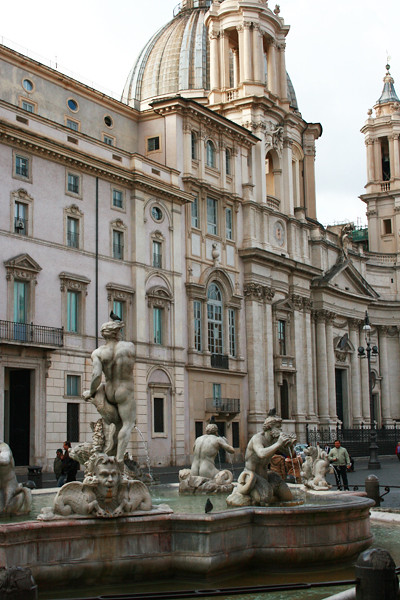
Jan '11 - Feb '12
Currently reading: Freedom by Jonathan Franzen
After starting and stalling four different times on a post about Florence, I’ve decided to move forward…
Last week was our first Rome trip. To be more accurate, it was comprised of Rome, Pompeii, Sorrento, Capris, and, briefly, Naples. The content and composition of the city is breathtaking, containing iconic historical sights from thousands of years of history, from the Etruscan to the Roman to the Baroque.
Our home-base for the week was the Hotel Albergo Sole, next to the Teatro di Pompeo, the historical site of Julius Caesar’s death at the hands of Liberatores of the Roman Senate. Hotel Sole occupies a small lot south of the Piazza Navona (which contains Borromini’s Sant'Agnese in Agone and Bernini’s Four Rivers Fountain).
Piazza Navona
To supplement our travels, we’ve been asked to read Timeless Cities by David Mayernik, explaining the evolution of the most important Italian cities. In the first chapter, which deals with Rome, Mayernik describes the city as a giant mnemonic device:
“Essentially the classic mnemotechnic used visual imagery – figures, buildings, and cities – as cues to help remember words and abstract concepts…Without the printing press, the ancient world put a high value on personal memory skills; one could in effect carry a library in one’s head…[E]ssentially one invented a mental architecture in the act of remembering a text that one mentally “revisited” when it was necessary later to recall the text…Conversely, when the Hellenistic architect thought about buildings and cities, he imagined them containing memories of ideas. Thus some of the same rules that governed the making of imaginary memory cities for the rhetorician also informed the architect’s process of making real cities memorable.” He calls this process, “mnemotectonics.”
Mayernik then goes on to explain the layout and composition of Hadrian’s villa as a series of “memory houses,” strung together to recall ancient literature, plays, or rhetoric (the names of the different sites within the villa – the Academy, the Lyceum, Serapeum, Canopus – may have evoked experiences from earlier travels and campaigning). These sites were organically positioned, so as to provide a more fluid narrative.
The papal Possesso route
Later in the chapter, Mayernik examines the Renaissance Papal processional route (Possesso) from the historical Roman Duomo, San Giovanni in Laterno, to the seat of Christendom, San Pietro (Saint Peter’s). The route, he explained, utilized the imagery of the city in order to reinforce the supremacy and piety of the Pope. In the Campo Marzio neighborhood, the processional ran through Monte Giordano, a stronghold of Medieval warring families, to mark the Papacy’s triumph over feuding factional family politics (try saying that nine times fast). Winding past the Capitoline Hill, the seat of government, the pope reinforced his status as king and supreme ruler. Passing Trajan’s column (topped with a statue of Saint Peter), one was reminded of the victory of the Church over paganism. As the procession wound through the Roman Forum and under the Arch of Constantine (the first Christian Emporer), one was reminded of the conversion of the empire from a polytheistic, Christian-persecuting entity to a religious, spiritually-ordained state.
The Capitoline Hill
St. Peter's -- The end of the Possesso route
My project for the semester seeks to draw upon this idea of the city as mnemonic (or mnemotectonic, to use Mayernik’s language) device. If you’ll recall, the project seeks to take a traditionally cloistered men’s fashion event (Pitti Uomo, held in the Fortezza da Basso in Florence) and to redesign the project using the traditional Italian cornerstones of ritual, processional, and marketplace in order to tie the project organically into the city and historical context.
Thus far research has involved a series of maps, deconstructing the city into its parts (transportation networks, landmarks, green and open space, geographic boundaries) and overlaying historical information. I hope to imbue the project with a narrative, pulling the history of the fashion and clothing industry in the city (mostly dealing with the rise of guilds -- Medieval unions involved heavily in shaping and maintaining the built city through commissions) and using this information to create a meaningful connection to the contemporary fashion world (including current fashion hubs and landmarks).
Mayernik later discusses how the Possesso began to shape the built city as Catholic sects and orders built churches along the route in order to be included in the narrative and tie itself to the papacy. The goal of this project is to create both an event and a framework for future growth of the industry within the city, one informed by and inextricably linked to the past.
...And as promised, pictures from the back courtyard of our study center:

A first-person account of the interior life of the College of Architecture, Planning, and Design at Kansas State University. This blog seeks to bring you the latest architecture news from the fabled Little Apple -- Manhattan, Kansas.
No Comments
Block this user
Are you sure you want to block this user and hide all related comments throughout the site?
Archinect
This is your first comment on Archinect. Your comment will be visible once approved.